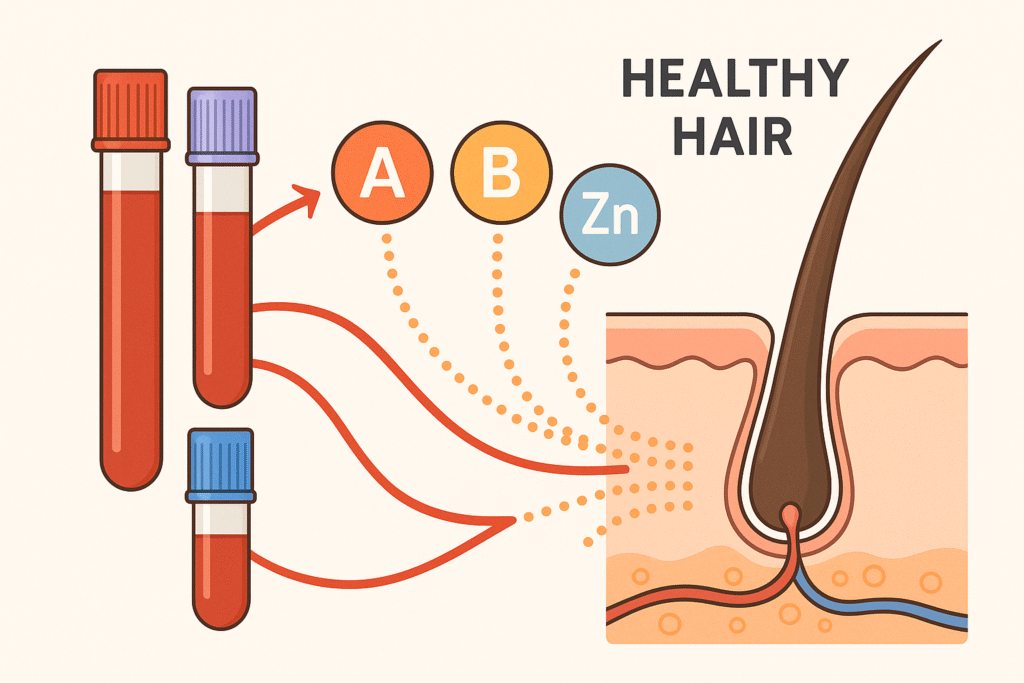Estimated reading time: 9 minutes
Finasteride for Hair Loss: The Definitive Guide (All You Need to Know)
Finasteride – A Game-Changer for Men’s Hair Loss
Are you a man struggling with hair loss? You’re not alone. Millions of men worldwide experience male pattern baldness, also known as androgenetic alopecia. This common condition leads to a receding hairline and thinning on the crown of the head. But there’s good news: finasteride, a prescription medication, has proven effective in combating hair loss and promoting regrowth. This definitive guide will explore everything you need to know about finasteride for hair loss, from the science behind it to potential side effects and realistic expectations for results
Table of contents
- Finasteride – A Game-Changer for Men’s Hair Loss
- What is Finasteride and How Does It Work for Hair Loss?
- The Benefits of Finasteride for Hair Loss
- Who Should Consider Finasteride for Hair Loss?
- Finasteride Dosage and Administration for Hair Loss
- Finasteride Side Effects and Precautions
- Combining Finasteride with Other Treatments
- Long-Term Use and Discontinuation
- Finasteride Myths and Misconceptions
- Alternative Hair Loss Treatments
- Conclusion
- Scientific Studies & Review Articles
- Medical Organisations & Expert Resources:
- Hair Loss GP Related Links
What is Finasteride and How Does It Work for Hair Loss?
Finasteride, sold under the brand name Propecia, is a medication that belongs to a class of drugs called 5-alpha-reductase inhibitors. It works by blocking the conversion of testosterone to dihydrotestosterone (DHT), a hormone that contributes to hair follicle shrinkage and hair loss in men with a genetic predisposition. By reducing DHT levels in the scalp, finasteride can slow or stop hair loss and, in many cases, even stimulate new hair growth.

The Benefits of Finasteride for Hair Loss
Numerous clinical studies have demonstrated the effectiveness of finasteride for hair loss. It has been shown to:
- Prevent Hair Loss: Finasteride can effectively slow or stop hair loss in most men who take it.
- Promote Hair Regrowth: A significant percentage of men experience visible hair regrowth, particularly in the crown area, after several months of consistent use.
- Provide Long-Term Benefits: The positive effects of finasteride for hair loss typically increase with continued use, with many men experiencing even greater hair growth and hair loss prevention after five years or more.
These benefits make finasteride a valuable tool for men seeking to address their hair loss concerns and regain their confidence.
Who Should Consider Finasteride for Hair Loss?
Finasteride is most suitable for men who:
- Have Male Pattern Baldness (Androgenetic Alopecia): This is the primary condition for which finasteride is approved and effective.
- Are in the Early Stages of Hair Loss: Finasteride works best when started early in the hair loss process, before significant balding has occurred.
- Have Realistic Expectations: While finasteride can be effective, it’s not a miracle cure. It’s essential to have realistic expectations about the potential results and understand that continued use is necessary to maintain any achieved hair growth.
Before starting finasteride for hair loss, it’s crucial to consult with a doctor or dermatologist to assess your individual situation and rule out any underlying medical conditions.
Finasteride Dosage and Administration for Hair Loss
- Standard Dosage: The typical dosage for finasteride for hair loss is 1mg per day, taken orally as a tablet.
- Generic vs. Brand Name (Propecia): Finasteride is available as both a brand-name drug (Propecia) and a generic medication. Generic finasteride is equally effective and often more affordable than Propecia.
- Consistency is Key: To achieve and maintain the best results with finasteride for hair loss, it’s essential to take it consistently as directed by your doctor. Skipping doses or taking it irregularly can reduce its effectiveness.
Finasteride Side Effects and Precautions
While finasteride is generally safe for most men, it’s important to be aware of the potential side effects:
Side Effects
- Common Side Effects: These include decreased libido, erectile dysfunction (difficulty getting or maintaining an erection), and changes in ejaculation (such as decreased volume). These side effects are usually mild and temporary, often resolving within a few weeks or months of starting treatment.
- Rare Side Effects: In rare cases, finasteride can cause more serious side effects, such as depression, anxiety, breast enlargement or tenderness, and allergic reactions. If you experience any of these symptoms, stop taking finasteride and consult your doctor immediately.
Precautions
- Women and Children: Finasteride should NEVER be used by women or children.
- Medical Consultation: Before starting finasteride, it’s crucial to consult with a doctor to discuss your medical history, current medications, and any concerns you may have.
Combining Finasteride with Other Treatments
While finasteride is effective on its own, combining it with other treatments can often lead to enhanced results:
- Minoxidil: This topical medication works synergistically with finasteride. While finasteride addresses the hormonal aspect of hair loss, minoxidil stimulates hair growth by increasing blood flow to the scalp and prolonging the hair growth cycle. The combination of these two treatments has shown to be more effective than either alone in numerous studies.
- Low-Level Laser Therapy (LLLT): LLLT uses red light to stimulate hair follicles and promote hair growth. Some studies suggest that combining LLLT with finasteride may further enhance results.
- Platelet-Rich Plasma (PRP) Therapy: PRP involves injecting a concentrated solution of your own platelets into the scalp. Platelets contain growth factors that can stimulate hair growth. PRP is sometimes used in conjunction with finasteride to boost hair regrowth.
Your doctor or hair restoration specialist can guide you on the most effective combination of treatments for your specific needs and goals.
Long-Term Use and Discontinuation
- Maintaining Results: It’s important to understand that finasteride is not a one-time solution. To maintain the benefits of hair growth and prevent further hair loss, you’ll need to continue taking it as prescribed by your doctor.
- Hair Loss Resumption Upon Stopping: If you stop taking finasteride, the effects will gradually wear off. The DHT levels in your scalp will increase, and hair loss will likely resume within 6 to 12 months.
This is why it’s crucial to view finasteride as a long-term maintenance treatment rather than a quick fix.
Finasteride Myths and Misconceptions
There are several myths and misconceptions surrounding finasteride. Let’s set the record straight:
- Myth: Finasteride causes permanent side effects. The vast majority of side effects associated with finasteride are temporary and resolve once you stop taking the medication.
- Myth: Finasteride will make your hair loss worse when you stop. While hair loss will resume once you discontinue finasteride, it won’t necessarily worsen beyond your baseline level.
- Myth: Finasteride is dangerous and harmful. While finasteride does have potential side effects, it is a safe and well-studied medication when used as directed and under medical supervision.
It’s essential to get accurate information from reliable sources, such as your doctor or dermatologist, to avoid being misled by false claims or exaggerated risks.
Alternative Hair Loss Treatments
While finasteride is a proven and effective treatment, it’s not the only option available for men with hair loss. Here are some alternatives to consider:
- Minoxidil: As mentioned earlier, minoxidil is a topical medication that can be used alone or in combination with finasteride for enhanced results.
- Hair Transplant Surgery: This surgical procedure involves transplanting hair follicles from one area of the scalp to another. It can be a good option for men with significant hair loss.
- Scalp Micropigmentation (SMP): This non-invasive procedure involves tattooing tiny dots on the scalp to create the appearance of hair follicles. It can be a good option for men who want to camouflage thinning hair or create a shaved head look.
- Lifestyle Changes: Adopting a healthy lifestyle can promote hair health and potentially slow down hair loss. This includes eating a balanced diet, managing stress, getting enough sleep, and avoiding smoking.
Conclusion
Finasteride is a valuable tool in the fight against male pattern baldness. It has been proven to be safe and effective for many men, offering significant benefits in terms of hair loss prevention and regrowth. However, it’s important to be aware of the potential side effects and consult with a doctor to determine if it’s the right choice for you.
If you’re struggling with hair loss, don’t despair. There are effective solutions available. By understanding your options and seeking professional guidance, you can take control of your hair loss and regain your confidence.
Recommended Read
Finasteride FAQ: Your Questions Answered
Finasteride is a prescription medication that treats male pattern baldness by blocking the conversion of testosterone to dihydrotestosterone (DHT), a hormone that contributes to hair follicle shrinkage and hair loss.
Finasteride is primarily effective for male pattern baldness, also known as androgenetic alopecia. It’s less effective for other types of hair loss.
It can take 3 to 6 months of consistent use to see noticeable results. In some cases, it may take up to a year to experience the full benefits of finasteride.
If you stop taking finasteride, the hair you’ve gained or maintained will likely be lost over several months, and your hair loss pattern may resume.
Finasteride is not intended for women and not safe for them to take. Pregnant women should not handle crushed or broken finasteride tablets.
Common side effects include decreased libido, erectile dysfunction, and changes in ejaculation. These are usually mild and temporary but can persist in some cases.
Rare but serious side effects include depression, anxiety, and allergic reactions. If you experience any unusual symptoms, consult your doctor immediately.
Yes, finasteride can be combined with other hair loss treatments like minoxidil for potentially better results. However, always consult your doctor before combining medications.
Yes, generic finasteride is bioequivalent to Propecia, meaning it has the same active ingredient and works the same way in the body.
Yes, finasteride is a prescription medication and should only be taken under the guidance of a qualified healthcare professional.
External Sources
Scientific Studies & Review Articles
Clinical Studies:
- Kaufman KD, Olsen EA, Whiting D, et al. Finasteride in the treatment of men with androgenetic alopecia. Finasteride Male Pattern Hair Loss Study Group. J Am Acad Dermatol. 1998 Nov;39(5 Pt 1):578-89. doi: 10.1016/s0190-9622(98)70007-6. PMID: 9822329.
- URL: https://pubmed.ncbi.nlm.nih.gov/9822329/
- Key Finding: This pivotal study established the efficacy of finasteride in treating male pattern baldness, showing significant hair growth improvement compared to placebo.
- Roberts JL, Fiedler V, Imperato-McGinley J, et al. Clinical dose ranging studies with finasteride, a type 2 5alpha-reductase inhibitor, in men with male pattern hair loss. J Am Acad Dermatol. 1999 Jul;41(1 Pt 1):52-7. doi: 10.1016/s0190-9622(99)70254-4. PMID: 10415791.
- URL:
- Key Finding: Investigated the optimal dosage of finasteride for hair growth, concluding that 1mg daily was effective and well-tolerated.
- Shapiro J, Kaufman KD. Use of finasteride in the treatment of men with androgenetic alopecia (male pattern hair loss). J Investig Dermatol Symp Proc. 2003 Dec;8(1):20-3. doi: 10.1046/j.1523-1747.2003.12172.x. PMID: 14675188.
- URL: https://pubmed.ncbi.nlm.nih.gov/14675188/
- Key Finding: A review article summarizing the clinical effectiveness of finasteride in managing male pattern hair loss, highlighting its long-term benefits.
Regulatory Information:
- U.S. Food and Drug Administration (FDA): Finasteride (Oral Route) Description and Brand Names.
- URL: https://www.mayoclinic.org/drugs-supplements/finasteride-oral-route/description/drg-20063819
- Key Information: Provides comprehensive information on finasteride’s approved uses, dosage, side effects, interactions, and precautions.
- American Academy of Dermatology (AAD): Hair Loss: Diagnosis and Treatment.
- URL: [invalid URL removed]
- Key Information: Offers a detailed overview of hair loss causes, treatments, and includes information on finasteride as a treatment option for male pattern baldness.
- National Institutes of Health (NIH): Finasteride.
- URL: https://www.ncbi.nlm.nih.gov/books/NBK548832/
- Key Information: Provides an overview of finasteride’s mechanism of action, clinical trials, safety, and efficacy.
Medical Organisations & Expert Resources:
- https://www.mymedshub.com/finpecia-1-mg.html
- www.cfspharmacy.pharmacy/blog/post/hair-loss-in-men-and-women-diagnosis-and-treatment-options
- citeseerx.ist.psu.edu/document?repid=rep1&type=pdf&doi=113b4d21e35a1061de3e77454f688f2ffc8730ee
- www.oxfordonlinepharmacy.co.uk/blog/why-finasteride-1mg-or-1-25mg
- www.nimbushealthcare.com/blog/why-nimbus-healthcare-does-not-use-finasteride










